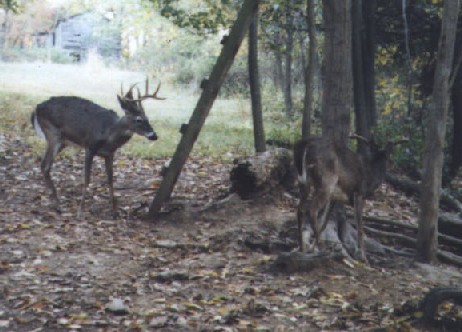|
Trophy Whitetail Bucks
|
The first thing that we need to do is define what they are, and there are many different definitions all depending on who you ask. The definition of a trophy whitetail buck is dependent on the individual. Some may feel that a trophy buck is any buck with a body weight over 200 pounds, antlers scoring over 150 inches, antler spread over 20 inches, non-typical antlers or antlers that have a lot of mass.
It is my opinion that the large majority of our deer herds do not need improved genetics. The evidence shows that nutrition, age and sex ratios play a more important role in developing trophy whitetail bucks as well as overall herd quality.
The size of a whitetail bucks antlers are determined by more that genetics. Several factors are responsible for the size of a bucks antlers including: age, nutrition, over population, buck to doe ratios, rainfall and winter severity.
Age is probably the most important factor in the majority of our deer herds. For too many years hunters have simply shot the first buck that comes along. Deer that do not grow up will never reach their genetic potential for antler size. Whitetail bucks generally do not reach their maximum antler size until they are 5 ½ years old.
Nutrition is also very important in determining antler size. Even a deer with good genetics and age will not grow large antlers on poor quality nutrients. On the other hand young bucks are capable of growing relatively impressive antlers when fed a high quality from early in life and would be considered trophy bucks by most hunters. Nutrition can also be affected in many ways that we cannot control. The quantity and quality of the mast crop, fruit crop and all forages is highly dependent on the weather.
Over population has many detrimental effects on the deer herd. An overpopulated deer herd can decimate the native forage in an area which of course lowers the forage quality available for the deer. Overpopulation also introduces stresses on deer that can hold back their development.
A buck to doe ratio that is out of balance will put too much pressure on the bucks. A whitetail buck will lose weight during the rut as he forgets about eating and spends his days and nights chasing does. When there are many more does than bucks the bucks run themselves ragged trying to service all of the does. In addition, when there aren’t any older bucks in the herd the young bucks are now doing all of the chasing and breeding. This activity runs the weight off of the young bucks that should still be growing. Ideally the older bucks in the herd should do the breeding while the younger bucks are less active and keep their bodyweight as they continue to grow.
Winter can be a difficult time on whitetail deer especially in the northern climates. Bucks that have survived the hunting seasons and have run off much of their body weight now find themselves with lower quality forage. A mild winter may allow a buck to go into spring in good condition while it is not uncommon for deer to perish during severe winters.
Should we shoot spikes? The answer is another question. Should we shoot a buck before he grows up? There are only two occasions where I feel that you should shoot a spike the first of which is, if the hunter is young and/or it is the first deer to be harvested by that hunter. To a young hunter a spike is a trophy buck. The other instance would be if the spike has a potbelly with a large body and is obviously an old deer. You can learn to age deer by just observing deer and looking at pictures of different age bucks. Look for the different characteristics that the different age bucks have such as a sagging belly, thicker neck and heavier muscled bodies as compared to young bucks. Aging bucks becomes easier as you let more bucks grow older and observe them more. I think that many times hunters shoot spikes thinking that they are an older deer. The truth is that this deer is just a promising young buck that has a larger body and is well on his way to being a real nice deer once he grows up.
Keeping the antlerless deer population under control is very important also. A large doe population will require more forage, increase the need for more bucks to complete the breeding and add to the social stresses.
The bottom line is that unless you have a fenced operation where you can completely control the deer herd you can improve the herd and trophy whitetail buck potential much more by improving the forage and keeping the population under control than worrying about genetics.

It is difficult to tell by this picture but on the occasions that I saw these two bucks together it was evident that the buck on the right was older than the buck on the left. The buck on the right had a larger body and neck and thicker wider antlers.
I have reinforced my own observations over the years through reading. One of the best sources is Deer and Deer Hunting Magazine.
Return from Whitetail Bucks and Genetics to Whitetail Deer Management.
